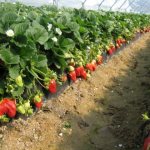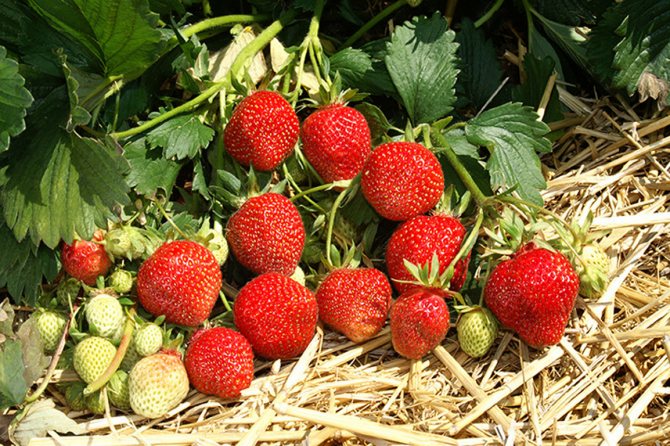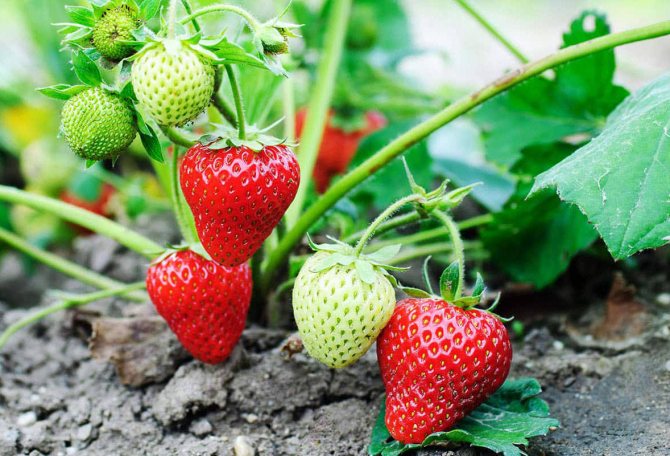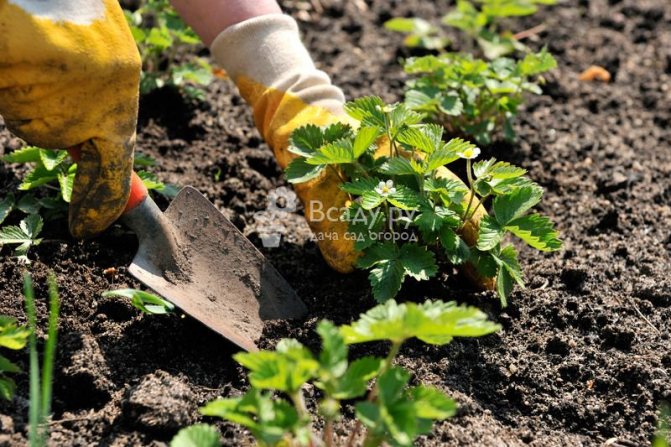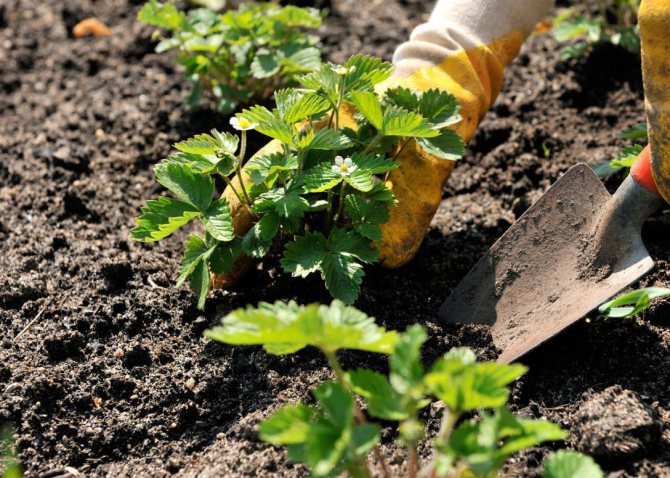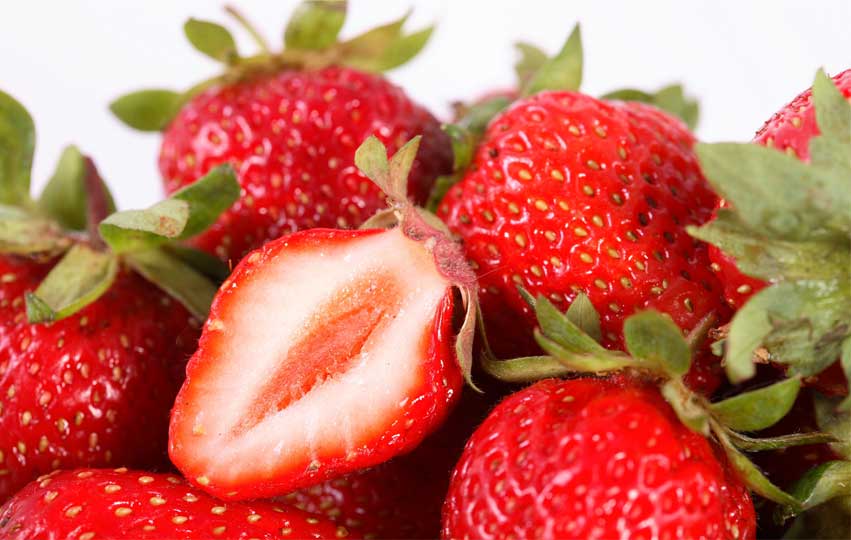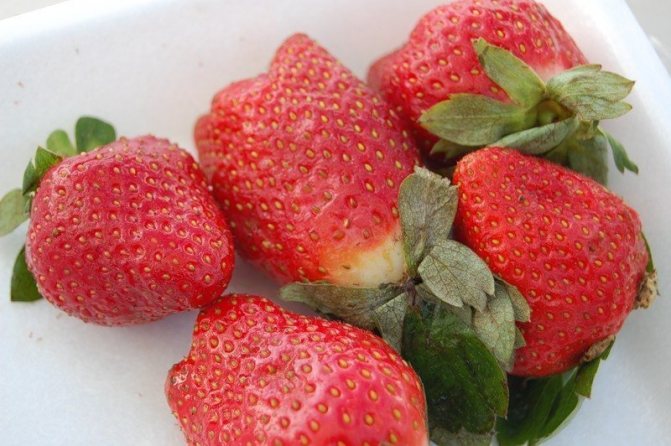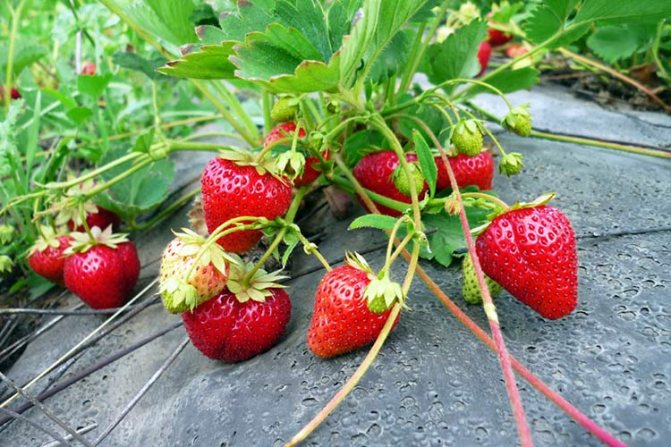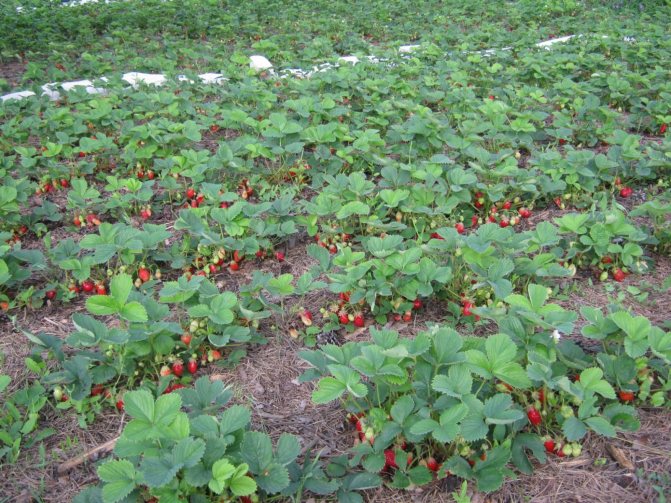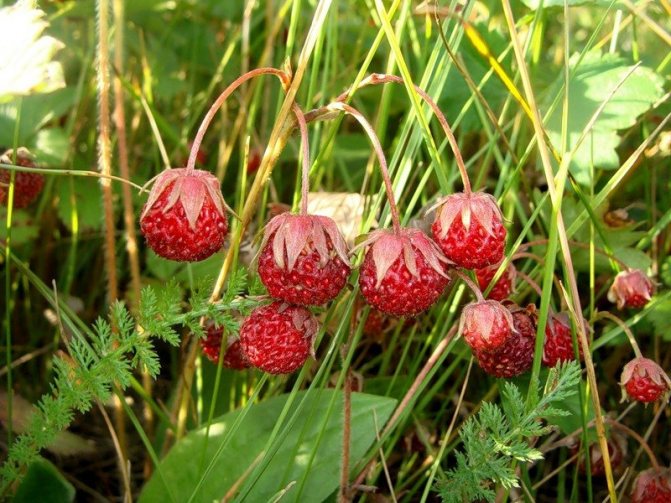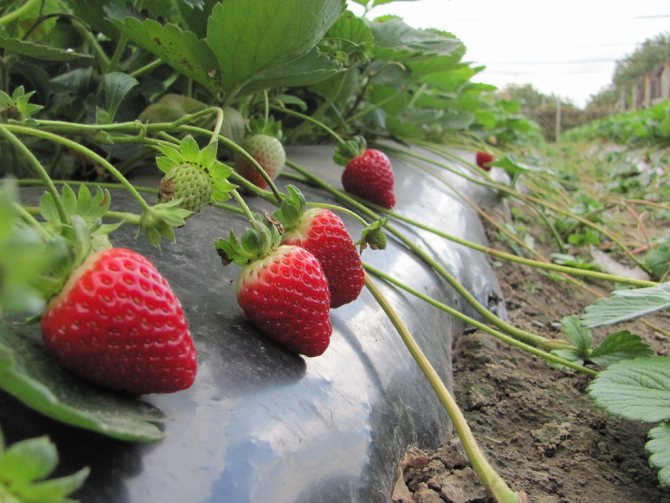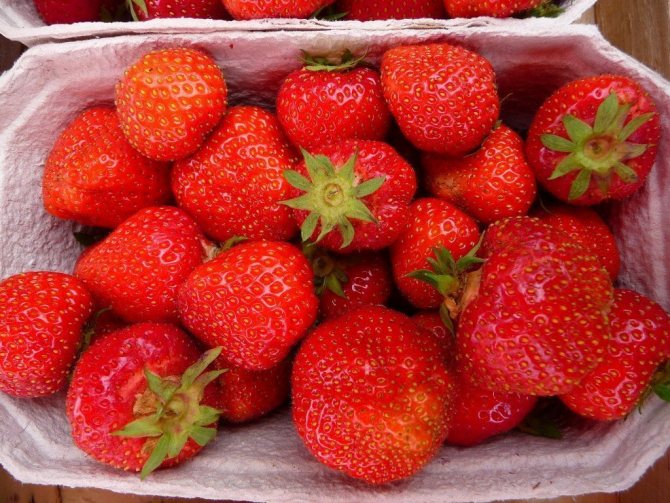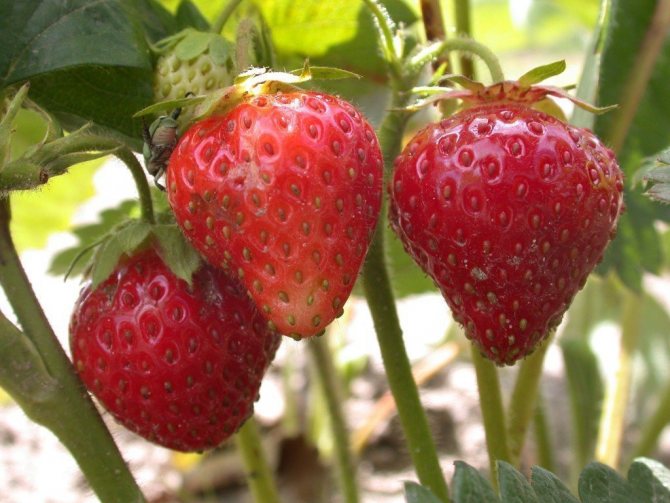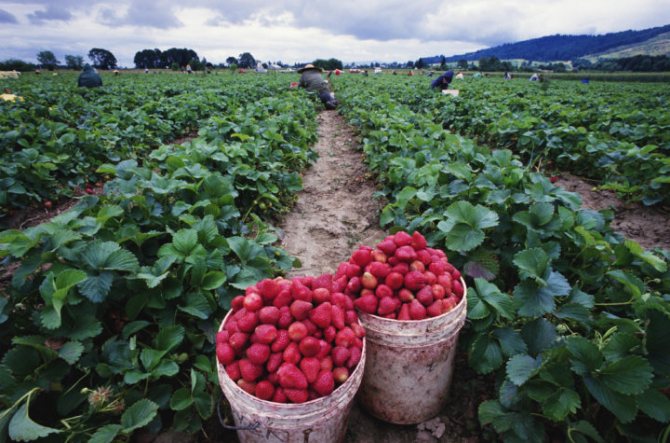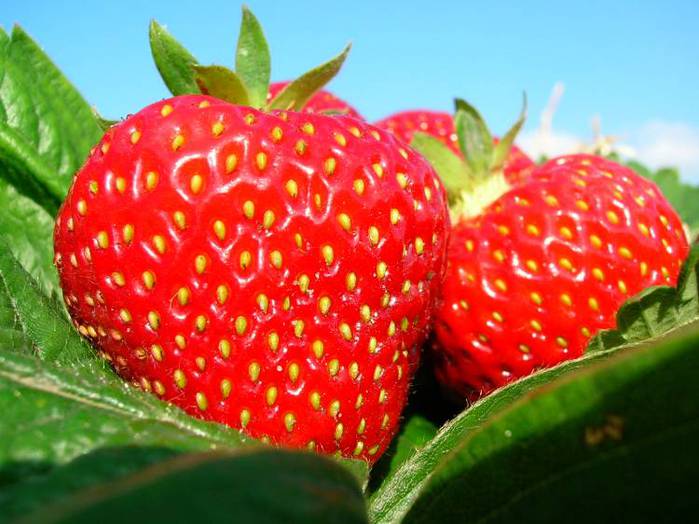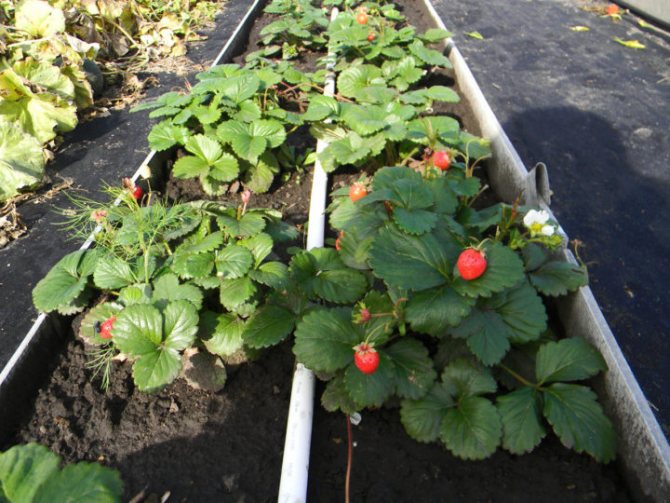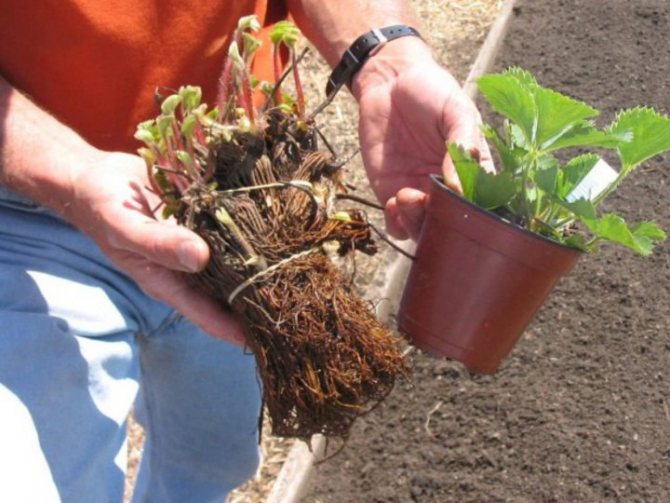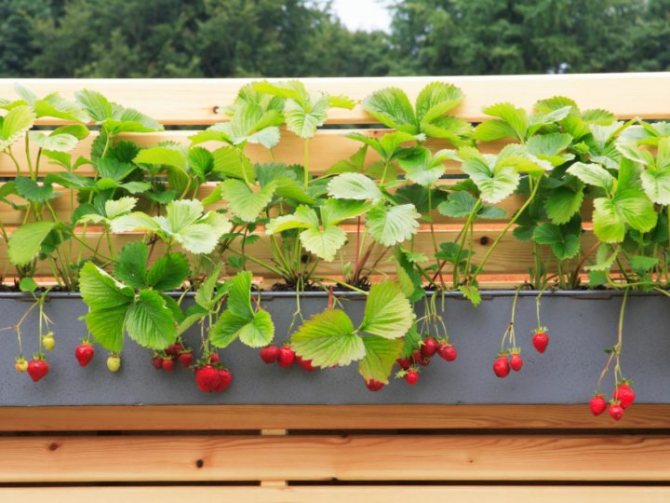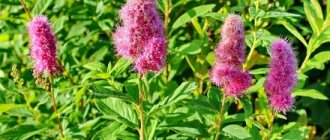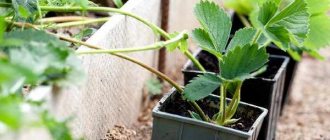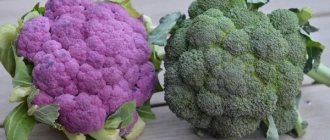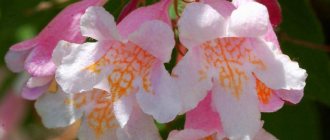Strawberries, growing and nursing in the open field is not a very difficult process, but it requires some effort. In order to harvest a bountiful harvest as a result, you need to choose the right variety of strawberries, buy healthy seedlings, prepare the land, take care of the strawberries, water them correctly, feed them, trim the mustache.
As a result, you will receive a bountiful harvest.
The best varieties of strawberries for planting in open ground
There are many varieties of this stocky berry, and each has its own advantages. So, most gardeners tend to grow remontant strawberries. These varieties can produce berries until autumn. In addition, they yield much more abundant crops than other varieties.

Bountiful harvest of strawberries
The best varieties of the remontant type:
- Mara de Bois. The variety is suitable for areas with cool climates. Yields juicy and beautiful berries, the seedlings are well suited for transportation. When transplanting, 95% of the bushes take root, which is considered a very good indicator.
- "Temptation". The berries of this variety have an unusual taste with nutmeg notes. You can achieve a yield of 3 kg of strawberries from one bush. The berries grow on bushes and mustaches and can be picked from mid-May to late September.
- "Albion". Suitable for southern regions. The bushes are equipped with large leaves that are able to hide the berries from the scorching sun. The first harvest ripens in the last decade of May. The berries are very sweet and beautiful.
- "Elizabeth 2". Russian breeders created this variety specifically for areas with constant cold. The bushes produce sweet berries that are equally good for canning, freezing and fresh. Fruiting begins in early June and ends at the end of September.


Strawberry varieties Temptation
Early ripening strawberry varieties:
- Elsanta. Originally from Holland, it produces sweet berries with a slight sourness. Strawberries ripen quickly, ideal for canning, but not suitable for long haul transportation.
- "Kama". Extraordinarily aromatic berries, the yield reaches 3 kg per bush. However, the variety is very demanding. Each bush must be mulched with dry grass, otherwise the berries will rot due to contact with the ground. They are very low and covered with leaves.


Kama strawberry variety
- Zephyr. Danish variety with a rich harvest and a large number of peduncles. The bushes are immune to diseases, but before winter they need to be insulated in the form of a hat made of dry straw or cut branches.
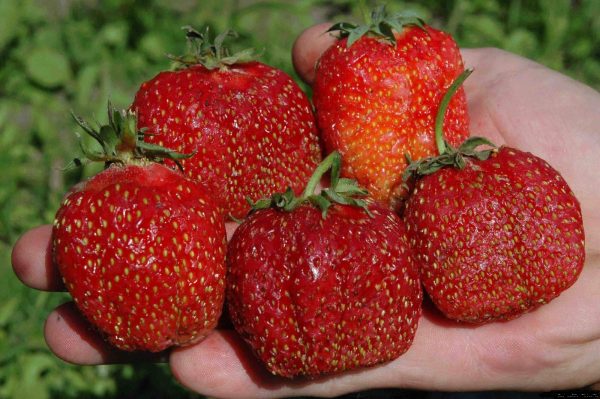

Marshmallow strawberry
Strawberries with large fruits:
- Honey. An excellent variety with a strong rhizome and vigorous growth. It has large berries with an extraordinary aroma. The crop can be harvested from mid-May to late June. Bushes give a lot of whiskers, which are cut and buried.
- "Gigantella". Gives berries up to 5 cm in diameter with dense juicy pulp. The bushes have large leaves, so you need to plant them away from each other. Differs in a high content of nutrients.
- "Festivalnaya" A variety with bright juicy berries that melt in your mouth. Up to 3 kg of strawberries can be harvested from one bush. Requires special care.
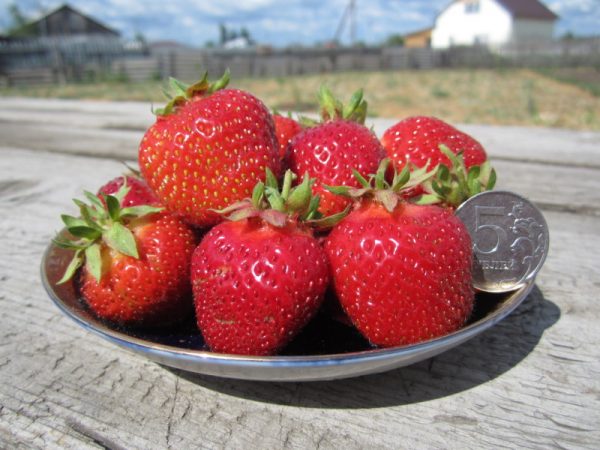

Festivalnaya strawberry
You can read more about growing remontant strawberries in our article.
Strawberry seed prices
strawberry seeds
When should you plant strawberries?
The first thing you need to decide on is the timing of planting strawberries. They may differ depending on the region where the summer cottage is located, or the preferences of the gardener himself.
For example:
- Middle zone of Russia and Moscow region. The preferred planting time is the last days of April or early August.
- Southern regions. The procedure is relevant in the first decade of September.
- North of Russia. The optimal planting time is late May / early June.
The most suitable time comes when the air temperature warms up to +15 ... +25 degrees. If a spring or summer planting is planned, the site is prepared in the fall. For an autumn planting, preparation is carried out a couple of weeks before the event.


No special soil is required for planting strawberries, universal soil is suitable
Preparing for planting strawberries
Further preparation for landing consists of several points. They are detailed in the table below.
Table 1. The process of preparing for planting
| Preparation stages | Features of execution |
| Seat selection | The site where the strawberry beds will be located must meet the following requirements: 1. Soil with acidity from 5.5-6.5 Ph. If the acidity is below this level, it can be increased by adding dolomite flour to the soil. These procedures are valid only in the fall. 2. Avoid planting on too wet soil. For strawberry bushes, a place where water accumulates after rain or melting snow is not suitable. Otherwise, the root system will actively rot. 3. Only loamy and sandy loam soil is used for strawberries. You need to make sure that it allows oxygen and water to pass through well, and also has good fertility. 4. The place should be well lit. Only in this case will the berries refuse bright and juicy. 5. On strawberry beds it is unacceptable to place other horticultural crops. Bushes and berries themselves grow more actively without neighbors. 6. Groundwater should flow at a depth of at least 70-80 cm from the surface. |
| Predecessors | Strawberry beds will be most appropriate in areas where in the previous season grew: - peas, beans, beans; - grain crops; - greens. Don't plant strawberries after potatoes or tomatoes. |
| Soil preparation | For the berries to be fragrant and juicy, the soil must be nourished. To do this, it is fertilized with a mixture of: - 8 kg of humus; - 100 g of superphosphate; - 30 g of potassium salt. The specified volume is sufficient for feeding 1 sq. m. soil. |
| Selection of seedlings | An important detail for a good harvest is the choice of seedlings. They must meet the following characteristics: 1. Absence of mechanical injuries on leaves and stems, as well as traces of disease. 2. The roots must be strong and strong. It is better to choose planting material with highly branched roots. 3. 3-4 young leaves should grow at the outlet. |
| Formation of beds | The beds must be formed in accordance with the place that was chosen for planting. So, on a hill, you can create a bulk bed from 10 cm.If the groundwater is located close to the soil, the height of the bed is increased to 35-40 cm.The most suitable bed width is 95-100 cm. |
When all the preparatory procedures are completed, it is time to plant strawberry bushes. Immediately before planting, the soil must be dug again to a depth of about 30 cm. This will saturate the soil with oxygen. Also, in the process, old roots and pests are removed.


Growing berries on an industrial scale
Protection against diseases and pests
Strawberries are loved not only by people, but also by insects, because the harvest of berries can simply be destroyed. Diseases are no less dangerous. To avoid this, it is necessary to carry out timely treatment with fungicides and insecticides.


The main thing is not to miss the terms recommended to ensure the procedure:
- the first treatment should be carried out in the spring after cleaning the beds from debris and old mulch;
- in the fall - after trimming the mustache;
- in summer - as needed.
For pest control, the following means are used:
- Actellik;
- "Shar Pei";
- Aktara;
- "Karbofos";
- "Zolon".
For preventive and full-fledged processing of strawberries from diseases, the following are used:
- bordeaux liquid;
- colloidal sulfur;
- copper sulfate;
- ferrous sulfate;
- Fundazol;
- Hom.
Attention! The listed funds are capable of working well on strawberries.
Don't forget about your own safety. All preparations belonging to the group of fungicides or insecticides are dangerous to humans, therefore it is necessary to work with them, fully protecting the respiratory organs, hands and eyes. Clothes used in the processing process must be washed with good quality.
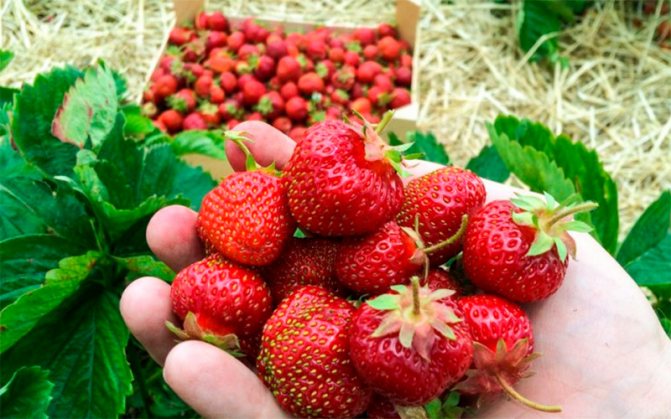

Children and animals must be removed from the site in order to exclude accidental intoxication. You can get the maximum benefit if you spray the culture in the evening, then the active ingredients can be fully absorbed.
Strawberry planting principles
Planting strawberry bushes occurs according to the following principles:
- The optimal boarding time is early morning or late evening. You need to choose the time so that there is no blinding sun outside. Otherwise, the young growth will burn, because it has not yet had time to adapt.
- According to the standard, the gap between the bushes should be left about 25 cm. From row to row, keep a distance of half a meter.
- The depth of the nest for planting a bush should be up to 15 cm.
- During planting, you need to ensure that the root collar rises above the surface. Otherwise, the plant will dry out in the near future.
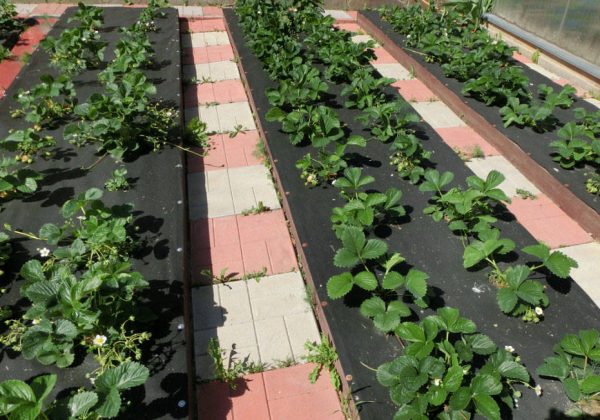

Planting strawberries under the film
Strawberry cultivation methods
There are many ways to ripen strawberries. For uncovered soil, the classic planting method will be most relevant. Other variations are considered non-standard and involve the use of auxiliary materials. These can be various containers or landscape slides.
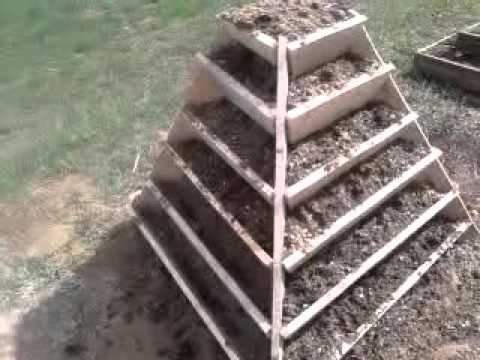

Strawberry pyramid
Option 1. Classic cultivation
There are 2 classical cultivation methods. It:
- One line. A distance of 60 cm is left between the rows, 15 cm between the strawberry bushes. Recommended for spring and autumn planting.
- Two-line. The gap between the rows is 30 cm, between the bushes - 20 cm.This method implies the presence of more plants than with a one-line version.
The distance between bushes and rows is provided in order to protect the growth from pests. If the grower is confident in the health of his plantings, the spacing can be slightly smaller.
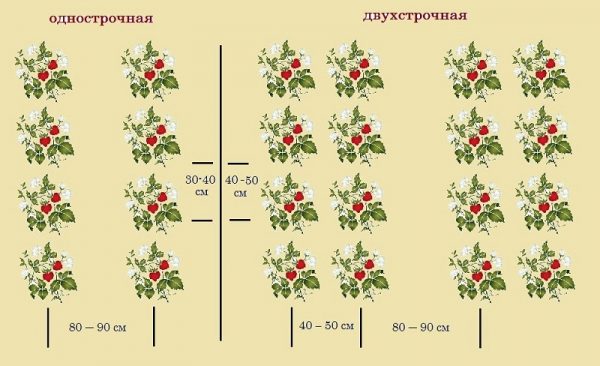

Classic strawberry planting schemes
Option 2. Non-standard growing methods
With classic growing methods, the beds can take up too much space. Non-standard growing methods have been developed especially for small garden plots. It:
- Vertical fit. In the case of vertical planting, the plants can be placed in pipes, in a special net, small pots or used car tires. The landing elements are arranged vertically, one under the other or staggered. The method allows you to significantly save space.
- Landing in packages. Plastic bags with fertile soil and strawberry seedlings are folded horizontally or hung on a vertical surface. Holes are left in the bags for the development of bushes.
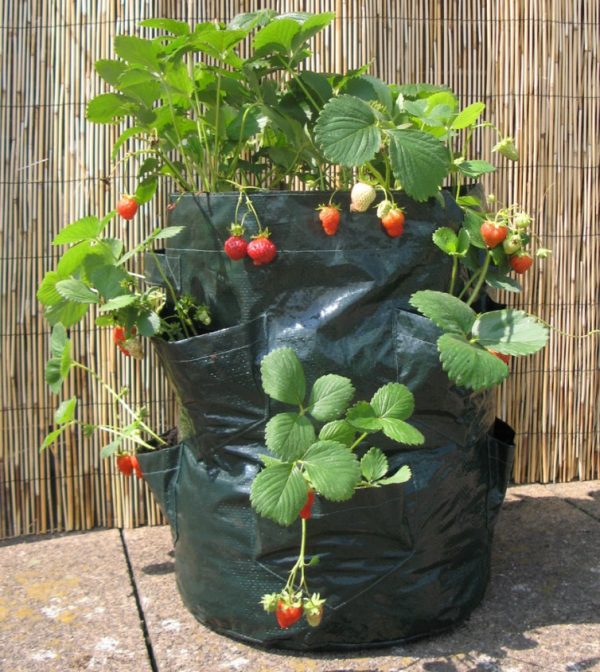

Growing strawberries in a bag
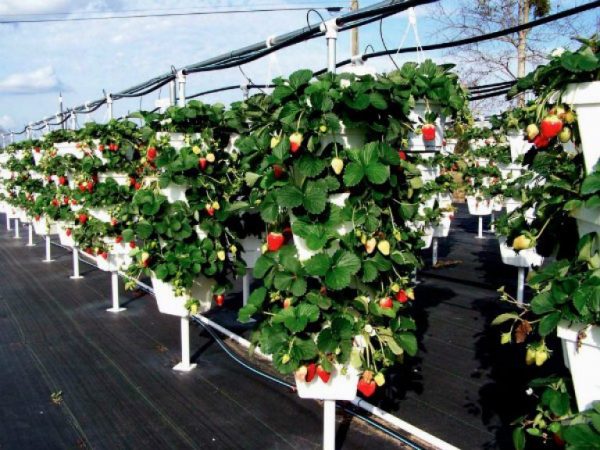

Vertical cultivation of strawberries in pots
How to plant remontant varieties
Renovation strawberries require a special approach.Her landing takes place according to the following principles:
- Repairing berry varieties require drainage. Therefore, during the creation of a bed, crushed brick or pebbles are poured under the ground.
- A mixture of compost, river sand and garden soil is taken as a fertile layer.
- Before planting, the seeds must be poured with water or a growth activator for several hours.
- The furrows for planting are prepared in moist soil, the holes are at a distance of 5 cm. The seeds are embedded in the soil no deeper than 50 mm, and then covered with glass or foil.
- When the seeds hatch, you need to pinch the roots at the ends. A repeated procedure is carried out when 3-4 leaves appear on the shoots.
Repaired strawberries are highly valued for their early harvests. She is able to bear fruit until the first frost. Moreover, from 1 sq. m. plantings, you can remove 1 kg of juicy berries.
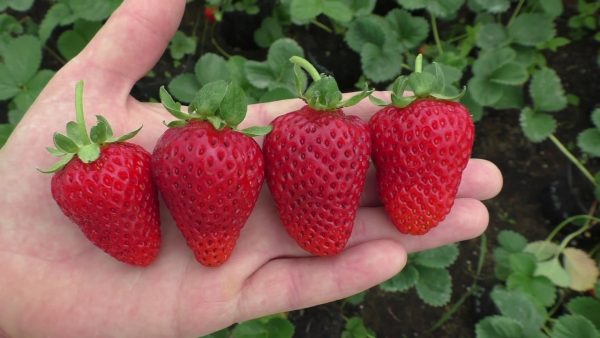

Repaired strawberries of the Albion variety
Prices for remontant strawberry varieties
repair strawberry seeds
Subtleties of care for a good harvest
After rooting, strawberries require special care. It is a moisture-loving crop, but watering must be done correctly. For the first 2 weeks after planting, watering the strawberries should be done every day. It is best to irrigate with a watering can so that the strong stream does not wash the roots out of the loose soil. Further, when the plants get stronger, you can water it once every 2 days.
Any weeds can negatively affect the yield of the crop, so it is very important to weed and loosen the row spacings in a timely manner. During the flowering period, you can feed the plants with diluted urea. After the berries appear, you should continue to monitor the cleanliness of the beds and regularly water the plants. After the start of budding and the formation of berries, you can fertilize with potassium nitrate.
Watering after the appearance of berries should be dosed. It is necessary that the soil after watering was moist, but not flooded to the state of porridge. The fact is that in this case there is a great risk of not only the appearance of various diseases, but also slugs, which love a humid environment and at the same time feed on berries. As the berries ripen, they should be picked without overripe.
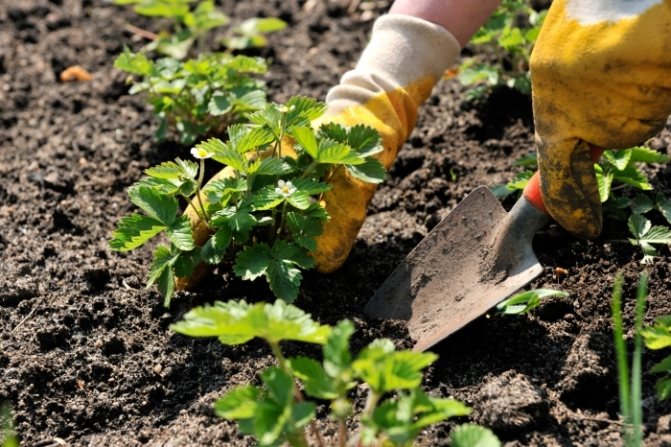

Preparing your own planting material
Many gardeners prefer to take planting material for growing from their own plot or from a neighbor's garden. This allows you to immediately know exactly what exactly will grow from the young growth.
Seeds or mustaches with rosettes are taken as planting material. So, with a seed planting method, the crop can be harvested in a year. And a rosette from a mustache, which was planted in spring, can give the first berries already this year.
The preparation of planting material is a very important stage in strawberry cultivation, therefore, when implementing it, you must heed the recommendations of experienced gardeners. All of them are presented below.
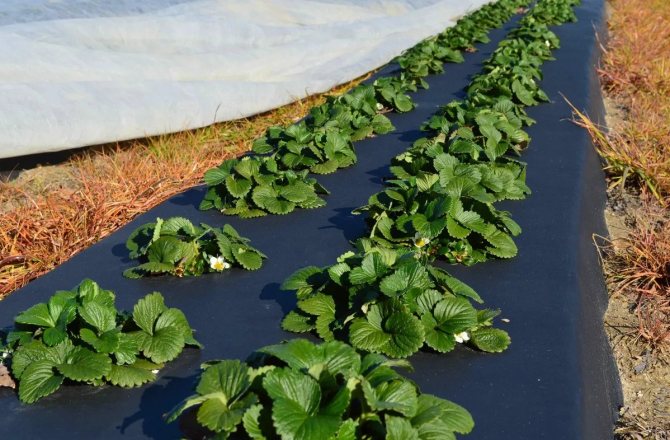

Planting strawberries under agrofibre
Collection of strawberry seeds
Harvesting seeds from existing berries is not easy. This can be done in several ways:
- Choose the largest and ripe fruits. From them you need to carefully cut off the top layer with seeds with a sharp knife. It is laid out on fabric and gently rubbed. The grains remain, which can then be easily collected.
- Put a few large juicy berries in a blender bowl, add water and beat. Pour the resulting liquid into a fine sieve, rinse the rest under running water. Collect the seeds from a strainer and dry.
- The most time-consuming method is to get the seeds out of the berries with a toothpick.
The planting material is washed through a fine sieve, then laid out on a paper napkin and dried. You can store seeds for 4 years.


Collection of strawberry seeds
Growing strawberry seedlings
Before sowing strawberries for seedlings, you must soak the seeds in warm water.When they hatch, they carry out the stratification procedure - they are placed in a vegetable box of the refrigerator in a humid environment.
Stratification lasts 1-2 weeks. During this time, the seeds are hardened, their immunity increases. Then they are dried and sown in boxes with fertile soil or peat tablets. The seeds are placed in shallow holes, which are lightly sprinkled with earth on top. Seedlings are grown in a warm, well-lit place. Plants are transferred to open ground when 4-5 leaves appear on them.
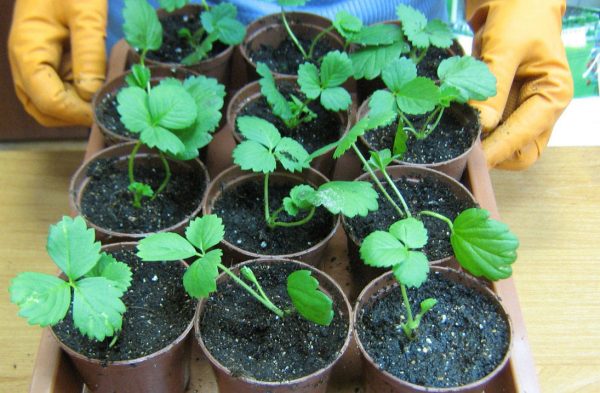

Growing strawberry seedlings
Mustache reproduction
A bush with abundant flowering should be selected at the beginning of July. He is closely watched throughout the season. The antennae should stretch out and grow in different directions. The further algorithm will be as follows:
- In early August, rosettes should form on the antennae. Small roots appear from them, which go into the ground. For cultivation, use the first 2-3 sockets from the mother bush.
- All children are cut off from the selected antennae, except for the first. He will subsequently become a new bush. The baby does not need to be cut off from the mother plant.
- Loose soil is poured around the bush and the soil is well moistened. It is necessary to create all conditions for the full development of the root system.
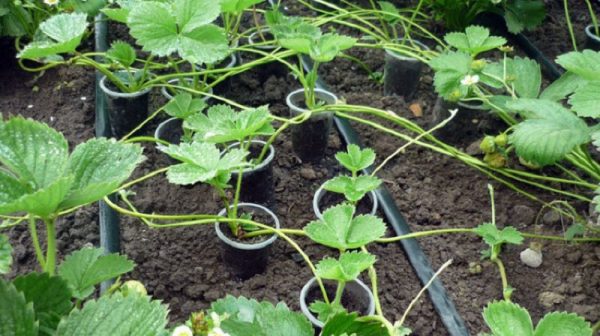

Propagation of strawberries with a mustache
Daughter bushes are transplanted in the second half of August. They must be cut off from the mother plant, carefully dug up and transferred to a new hole.
Important! For planting, use the rosettes that are rooted closest to the bush. The further the outlet is, the weaker the new strawberry bush will be.


Strawberry whiskers with roots
Stages of spring work
Planting strawberries in spring is carried out in open ground in the following sequence:
- we first fertilize the garden with humus and dig up;
- we make the holes for strawberry bushes shallow; when digging, you need to take into account the distance between the rows - 40-70 centimeters (the distance between the bushes does not exceed 30 centimeters);
- in the absence of humus, fertilizer with microelements is introduced into the hole (mix the soil with fertilizer so as not to burn the roots);
- the seedling is placed vertically in the hole;
- the holes are watered with water, half a liter is recommended for each bush;
- the apical bud should be flush with the ground, otherwise the root will rot or freeze during frosts;
- the ground around the seedling should be tamped, and the mustache and damaged leaves should be cut off;
- between the rows we make horizontal grooves into which water is poured, the bush itself should not be watered, so that a crust does not form, which impedes the flow of oxygen to the roots;
- after watering, cover the furrows with peat, hay or straw, which saves the strawberries from drying out.
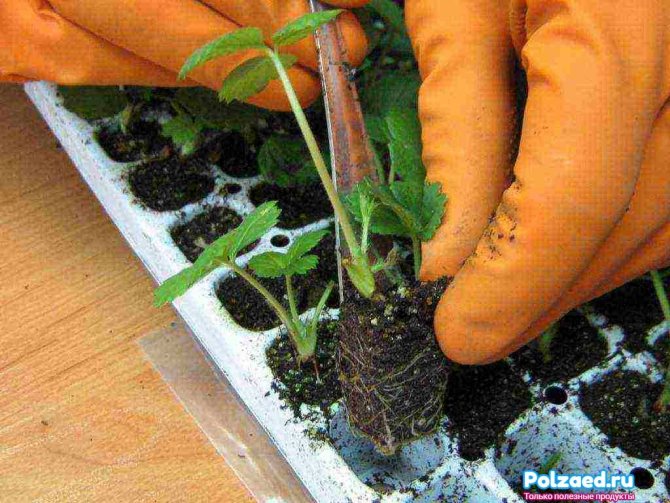

Autumn work falls on the beginning of the season (late August - mid September). Before the onset of frost, the sprouts will have time to acclimatize and take root. If everything is done correctly, then the first harvest ripens the next year.
The garden bed on which the bushes are being erected can be covered with agrofibre, hay or straw. The main thing is that the berry does not come into contact with the ground.
How to care for strawberries after planting
To get a rich harvest of juicy strawberries, you need to properly care for the bushes. Without proper care, it will not be possible to achieve high-quality fruits, even if the bushes are planted in the right place. The principles of caring for strawberries are presented in the table below.
Table 2. Care of strawberries after growing
| What do we have to do | Features of the |
| To water | Strawberries need to be watered regularly. The main condition for watering is not to dry out the soil. The first 3-4 days after planting, the soil is watered daily, then every other day. The procedure is carried out with settled water in the evening. |
| Mulch | In early spring, it is necessary to carry out the mulching procedure. This will protect the berries from contact with the ground and subsequent rotting.In addition, it works as a weed prevention. There are several ways to mulch: 1. Organic. Humus, manure, or fresh grass. Additionally enriches the soil. 2. Inorganic. Plastic bags, small stones or granite chips. 3. Specialized. Mulching with special paper, which is sold in a flower shop. It protects the plant from weeds, fungi, frost and heat. |
| Fertilize | The feeding principles depend on what stage the plant is in. For example: 1. During the ripening of buds, formulations with potassium are used: potassium magnesium, potassium sulfate or potassium chloride. 2. For a bountiful harvest, the bushes are pollinated with boric acid mixed in water: 1 tsp. preparation in a bucket of water. 3. In the process of flowering, strawberries are fed with organic matter - chicken manure or wood ash. 4. After the last harvest, the bushes are fed with nitroammophos - 2 tbsp. on a bucket of water. |
| Protect from pests | As a prophylaxis against diseases and fungus, strawberries are treated with the following compounds: - copper oxychloride: against gray rot; - "Fitosporin": from the fungus; - solution of potassium permanganate: from powdery mildew. |
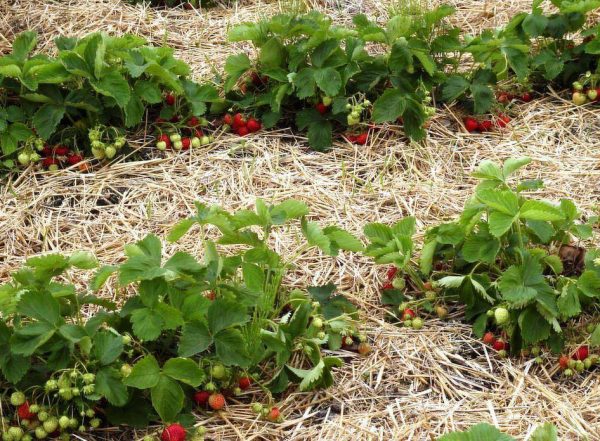

Mulching strawberries with dry grass


Common strawberry pests
What fertilizers are applied under strawberries in spring
If you are just going to plant strawberries, then first add organic fertilizers to the garden bed and dig up the ground in it. The best fertilizer for planting and its rapid growth is rotted cow dung. The first applied fertilizers are phosphorus-potassium fertilizers. For the first year after planting, try not to apply nitrogen-containing fertilizers. They will only enhance the growth of foliage, and the plant can become sick. The first feeding in the spring must be done even before the foliage bloom, when the snow has melted and the temperature is above zero.
Also, remember to pick off dried leaves and loosen the ground around the bushes.
Spring feeding table for strawberries
| Form of development | Period | Fertilizer type | Number of weeks | Quantity kg / ha week | Quantity kg / ha phase |
| The beginning of development - the end of flowering | April-early May | Master 17 + 6 + 18 Urea | 4 | 18 | 72 |
| Ovary-end of fruiting | early May-late June | Master 3 + 11 + 38 Urea | 8 | 12 6 | 96 40 |
| End of fruiting | July-early September | Master 17 + 6 + 18 Urea | 8 | 14 6 | 112 48 |
| Total | April-early September | Master 3 + 11 + 38 Master 17 + 6 + 18 Urea | 20 | — | 72 208 88 |
In the second year after planting (transplanting), top dressing is done in spring and autumn. For these purposes, a mullein solution is used, diluted 5 times with water and adding ash - 200 g per 8 liters of solution. Water the plant with the resulting liquid. Chicken droppings can be used instead of mullein. Pre-soaking it with 1 to 2 water, and infusing for 10-15 days. Then the resulting solution is diluted 1 to 8-10 and watered.
It bears fruit very well if fertilized with ammonium nitrate. Sprinkle at the rate of 80-120 g per 8-12 square meters. m beds. Instead of nitrate, the plant is fertilized with urea. These fertilizers will enrich the plant with nitrogen. They are especially important in the third and subsequent years of growing in one place without transplanting.
Also, the berry needs phosphorus-potassium fertilizer. It is brought in at the rate of 200 g per 10 sq. meters of land. There are also various fertilizer mixtures that are sold in prepackaged packages. They can also be used, but read the composition first.
Not always everything that is sold is useful, and various kinds of chemistry will not benefit either the crop or you, after using it.
After applying any fertilizer, it is advisable to water the bed abundantly so that the fertilizer is absorbed into the soil. After harvesting, towards spring, some gardeners recommend mowing or cutting off large leaves to stimulate the growth of the young. Whether it is useful or harmful, I have not applied this practice, so I cannot say anything about it.

